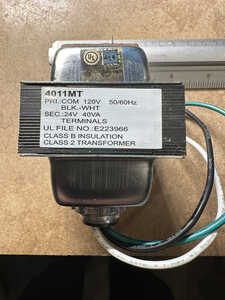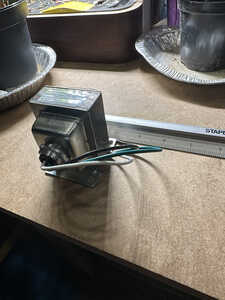I have a small transformer (4cm x 2cmx 3cm) it was bought new from a "reputable" vendor from A Express but I still was not sure such small package could have an output of 24V, I plugged it to a 110v outlet and my DMM measures 36V.
I do understand a few volts higher when there's no load but 36V makes me think the transformer was mislabeled or maybe faulty.
What other test should I run to verify the correct output? is the 36V no load output a reasonable output for a 24V transformer ?
Your help is much appreciated.
Ken.
Ken from Peterborough
@ddistrbd1 Hi Ken. The obvious question is what does the label say on the transformer? The size is certainly on the small size, but it depends on the amount of current it is capable of. It will likely be quite small as in under an amp but that is a real SWAG on my part. My 24V transformer is marked 40VA so the current is 40/24 or roughly 1.7A. 5cm x 6cm x 7cm
First computer 1959. Retired from my own computer company 2004.
Hardware - Expert in 1401, and 360, fairly knowledge in PC plus numerous MPU's and MCU's
Major Languages - Machine language, 360 Macro Assembler, Intel Assembler, PL/I and PL1, Pascal, Basic, C plus numerous job control and scripting languages.
Sure you can learn to be a programmer, it will take the same amount of time for me to learn to be a Doctor.
@zander ,Thanks for your post, the only thing I could find on the label is, :
input: 110v
Output:24V
Found the seller online and the only info to add: it produces 2Watts.
Ken from Peterborough
@zander ,Thanks for your post, the only thing I could find on the label is, :
input: 110v
Output:24V
Found the seller online and the only info to add: it produces 2Watts.
Found a calculator online:
0.083333 amps
Don't know if that sounds right.
Ken from Peterborough
@ddistrbd1 OUCH, I know Watts and VA are not the same, but they are close enough, so the current that little xfrmr can handle is 2/24 or 0.083A or 83 ma. Probably totally useless for what you want.
Do you know how much current your project will require? I bought my 110V/24V/40VA for the linear PSU. I had to settle for 40VA whereas Bill used a 72VA. If/when that proves to be insufficient, I am hoping the inventory levels will be back up.
First computer 1959. Retired from my own computer company 2004.
Hardware - Expert in 1401, and 360, fairly knowledge in PC plus numerous MPU's and MCU's
Major Languages - Machine language, 360 Macro Assembler, Intel Assembler, PL/I and PL1, Pascal, Basic, C plus numerous job control and scripting languages.
Sure you can learn to be a programmer, it will take the same amount of time for me to learn to be a Doctor.
@ddistrbd1 Yep, that's what I get too. Do you understand that is a tiny amount of current? It's 83/1,000, or 83 mA. What did you buy it for?
First computer 1959. Retired from my own computer company 2004.
Hardware - Expert in 1401, and 360, fairly knowledge in PC plus numerous MPU's and MCU's
Major Languages - Machine language, 360 Macro Assembler, Intel Assembler, PL/I and PL1, Pascal, Basic, C plus numerous job control and scripting languages.
Sure you can learn to be a programmer, it will take the same amount of time for me to learn to be a Doctor.
@ddistrbd1 Yep, that's what I get too. Do you understand that is a tiny amount of current? It's 83/1,000, or 83 mA. What did you buy it for?
Yes I do understand , 83 MA, it is tiny, I did not buy it for any particular project. it was too cheap to pass.
I was questioning the 36 volt output VS the 24V that was on the label.
The PSU I was working on is almost complete, it uses the same transformer you have ( in your first reply), I did not use a selector switch in my PSU, don't need the extra 3,5 9 volt. I just followed what Bill's diagram shows , good and safe, it works as it should. still waiting for a larger display.
I am now looking for a better transformer with 3A , prices are too high on Amazon.
Ken from Peterborough
Hi Ken @ddistrbd1 ,
There is a saying about "If something looks too good to be true ...it probably is" and I rather fear this may be close to that situation.
To make a physically small transformer for something like mains 5:1 voltage reduction, the wires have to be very thin to physically fit enough turns in the space. Thin wires, and lots of turns, suggests the effective source impedance at the power output is likely to be quite high, as the wires will also have considerable resistance. (These wires make hairs look-like tree trunks!)
All transformer windings have some resistance, so it is normal for transformers to give a slightly higher voltage output on no-load to compensate for the internal resistance ... however, 5-10% higher was the range I would normally expect, not 50%.
Perhaps, measuring the voltage after fitting a resistance load of the appropriate value to take 100% power output at 24V would reveal a value closer to the expected 24V.
However, you may then find the transformer is dissipating rather more heat than the load resistor .. so it will run hot and may have a brief life. I would also have some doubts about its insulation between primary and secondary.
Personally, you might like to keep it for some yet to be thought of experiment or demonstration in the future, but if it were mine, I would be very reluctant to use it connected to the mains.
Sorry, but unsuitable transformers connected to the mains can do a lot of damage when they fail, and may even be lethal.
Best wishes and stay safe, Dave
Hi Ken @ddistrbd1 ,
There is a saying about "If something looks too good to be true ...it probably is" and I rather fear this may be close to that situation.
To make a physically small transformer for something like mains 5:1 voltage reduction, the wires have to be very thin to physically fit enough turns in the space. Thin wires, and lots of turns, suggests the effective source impedance at the power output is likely to be quite high, as the wires will also have considerable resistance. (These wires make hairs look-like tree trunks!)
All transformer windings have some resistance, so it is normal for transformers to give a slightly higher voltage output on no-load to compensate for the internal resistance ... however, 5-10% higher was the range I would normally expect, not 50%.
Great explanation, thank you Dave.
Perhaps, measuring the voltage after fitting a resistance load of the appropriate value to take 100% power output at 24V would reveal a value closer to the expected 24V.
I have a 12VDC puck light I could use as my load, if the transformer get too hot and burn it's alright as long as I do it safely with the correct wiring. I jgot just the right diagram on how to test /measure the amperage.
https://www.youtube.com/shorts/dfzm3r8VyOw
Thank you again Dave , I will move forward with safety as my top priority. will triple check all the connections. no worries.
Ken from Peterborough
Before you remind me, I know I must change the AC output to DC. I have done that already.
Ken from Peterborough
Hi Ken @ddistrbd1,
I am not sure what kind of light you are discussing, but remember the spec you quote is 2W ... feasible with LEDs, but probably less than my battery powered headlight.
As well as the obvious shock risk of insulation breaking down, transformers can overheat and cause major fires ... they have a kind of self-destructive mechanism that progressively accelerates.
If you insist on using it, in spite of my concerns, make sure the frame is connected to earth (i.e. the third pin in a mains socket, sometimes called protective ground, etc.) and that the supply has an RCD trip that cuts the power as soon as it detects a small current flowing to earth.
And keep your fingers crossed for good luck!
Stay safe my friend, Dave
It showed 0.038A and then nothing, the transformer 's fuse must have blown. it didn't even get warm. That's it for this experiment, I can feel the fuse under the yellow tape on the transformer coil. might try to replace it.
Dave Thank you for every advice you have given me, I don't dismiss anything you have to say and trust me when I say, I take it all seriously . I am having fun here though, learning the basics is not even boring.
Ken from Peterborough


